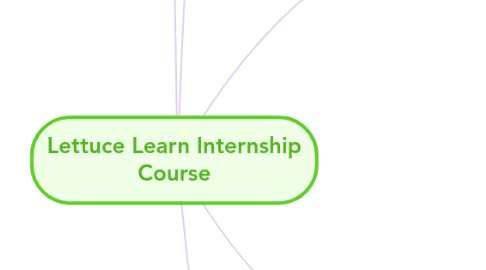
1. Lettuce Learn Course Development for Interns
1.1. Anything that looks like this is a learner objective
1.2. Anything that looks like this is describing the course phases
1.3. Anything that looks like this is an assessment of learning and projoect successes and failures
2. BEFORE THE COURSE/INTERNSHIP: Assess previous understanding, skills, and applications related to gardening, teaching, nutrition, and sustainable living
2.1. List skills that relate to the internship
2.1.1. SELF ASSESSMENT (Reflective 1 page paper due with application that displays these statements
2.1.2. Do you have any specific hopes, plans, goals or ideas to try out during this internship?
2.2. Illustrate how this internship will fit into professional goals
2.3. Discuss areas of previous knowledge and areas that need to be explored further during intern's Phase 1
3. PHASE 1 PROCEDURAL SCAFFOLDING: When interns first sign in to course, there is an introductory FAQ section that explains the site tools and a forum for posting additional questions. The first assignment is to prove comprehension of site navigation.
4. Phase 1: EXAMINE BACKGROUND INFORMATION and KNOWLEDGE -Intern will gain the ability to remember and analyze current food issues
4.1. Identify benefits of a school garden
4.1.1. TESTING ASSESSMENT: Quizes through Ted Ed or other lessons where student can perform self-guided how-to and educational videos accompanied by interactive testing
4.1.1.1. PHASE 1 METACOGNITIVE SCAFFOLDING Quizzes that visually check off as students complete each lesson.CONCEPTUAL SCAFFOLDING with study guides that outline the general concepts for this phase
4.1.1.1.1. THIS ALSO WORKS TO ADD A GAME COMPONENT, LEVEL COMPLETE
4.1.1.1.2. STRATEGIC SCAFFOLDING in the form of mentor meetings.
4.2. Define and share food and nutrition concepts and issues
4.2.1. COLLABORATIVE ASSESSMENT: With faculty at school, create some simple visuals for basic concepts that you are reviewing/learning that you think the kids would also benefit from learning.
4.3. Discuss the basics of garden development, problems, planning
4.4. Ability to Interpret gardening knowledge, garden benefits, history of particular assigned garden into assigned space needs
4.4.1. Write one sample assessment about the previous year in any format that you will follow bi-weekly throughout the semester to assess personal and project-wide progress, successes, & failures
4.5. Ability to summarize basic educational concepts for preschool children, including an ability to work practically on the language and understanding levels of assigned classroom
4.5.1. Using this knowledge, create (or find and adapt) a simple ACTIVE learning lesson for preschoolers incorporating STEM principles
5. Phase 2: EXPERIMENT AND ILLUSTRATE IMPLEMENTATION PLAN-Intern will demonstrate application of Phase 1 by relating the information to the assigned space and experimenting with a specific plan of action
5.1. CREATE A TIMELINE: The Growing Timeline including at least one Garden Work Day, and one Community Outreach Event (For example: Harvest day or Parent day, International Peace Day)
5.2. Planning Educational Activities and Lessons
5.2.1. Mapping of the Garden
5.3. Plan roles and responsibilities with school staff
5.3.1. COLLABORATIVE ASSESSMENT: Create a breakdown of what the intern is responsible for
5.4. Calculate potential successes and hopes for garden implementation
5.4.1. PERFORMANCE BASED ASSESSMENT: Sharing plans, maps, and ideas for recruitment, and projected successes and hopes with Mentors and Intern Peers in a Presentation just after school finishes
6. Phase 3: CREATE- Intern will combine the original knowledge gained in phase 1 with the plans drawn in phase 2 to implement the garden in the space
6.1. Construct a garden in real time
6.1.1. SELF-ASSESSMENTS: Maintain a bi-weekly reflection of progress, successes, failures following a simple formula that intern sets out for themselves
6.2. Execute planned map and lessons
6.3. Manage and guide volunteers
6.4. Measure successes and failures along the journey, making decisions for improvement during production
6.4.1. PORTFOLIO: Every week, take and post photographs and write short updates of work being done, including how and what children are learning. Provide specific examples. This can be in collaboration with self-assessment, or can be the public portion with the self-assessment being more personal reflection, this is up to the intern
6.5. Informing mentors of new recommendations for project
6.6. Metacognitive Scaffolding: Learner must pull from knowledge gained in Phase One and assignments from Phase 2 to carry out assignments in Phase 3
7. Phase 4: REFLECTION AND ANALYSIS
7.1. Conclude successes and failures based on original analysis and new information gained throughout the internship
7.1.1. PERFORMANCE BASED ASSESSMENT: Present portfolio and some portion of the self-assessments to an audience of peers, mentors, and community members
7.1.2. Strategic Scaffolding: Here the mentor must work with the individual learner to find the areas that they focus on best in their evaluations of their experiences
